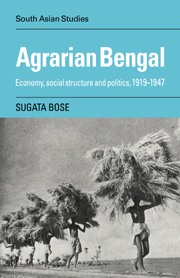Book contents
- Frontmatter
- Contents
- List of maps
- Preface
- List of abbreviations
- PART I AGRARIAN ECONOMY AND SOCIETY: STRUCTURE AND TRENDS
- PART II PEASANTS AND POLITICS
- 6 Agrarian class conflict, nationalism and communalism in east Bengal
- 7 Agrarian relations and mass nationalism in west Bengal
- 8 Sharecroppers' agitations in the frontier regions
- Conclusion
- Glossary
- Select bibliography
- Index
8 - Sharecroppers' agitations in the frontier regions
from PART II - PEASANTS AND POLITICS
Published online by Cambridge University Press: 24 October 2009
- Frontmatter
- Contents
- List of maps
- Preface
- List of abbreviations
- PART I AGRARIAN ECONOMY AND SOCIETY: STRUCTURE AND TRENDS
- PART II PEASANTS AND POLITICS
- 6 Agrarian class conflict, nationalism and communalism in east Bengal
- 7 Agrarian relations and mass nationalism in west Bengal
- 8 Sharecroppers' agitations in the frontier regions
- Conclusion
- Glossary
- Select bibliography
- Index
Summary
The crisis in agrarian relations in the rich-farmer–sharecropper system of north Bengal unfolded on a slower moving time-scale than in east Bengal. The climactic date here is 1939 rather than 1930. ‘There are no signs of discontent, and one hears of no revolts of adhiars, or adhiar class consciousness,’ says the Dinajpur Settlement Report. But it had to be added in a footnote, ‘In the last two months (January and February 1940) this statement has been falsified, for there has been trouble between adhiars and jotedars in Atwari and Thakurgaon, as well as in the adjacent parts of Jalpaiguri.’
The force of the world depression did not immediately rupture jotedar–adhiar relations as it did the ties between peasant-debtors and the various moneylending groups in the highly monetised small peasant economy of east Bengal. Nor did it result in a clear strengthening of ties of dependence as in west Bengal where moneylending landlords maintained their position in the khamar sector and made important gains at the expense of a more widespread, but weakening, peasant smallholding sector. Substantial landholders of north Bengal, who cultivated large blocks of jotes through tied adhiars, continued grain loans in return for labour services. In instances of more decentralised sharecropping, jotedars became wary of making grain advances and preferred to sell grain in the lean months on a definite understanding of deferred payment in cash.
- Type
- Chapter
- Information
- Agrarian BengalEconomy, Social Structure and Politics, 1919-1947, pp. 252 - 273Publisher: Cambridge University PressPrint publication year: 1987



